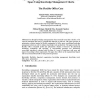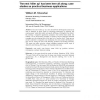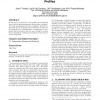1365 search results - page 198 / 273 » Learning with Product Units |
COMPSAC
2008
IEEE
15 years 23 days ago
2008
IEEE
Model-driven engineering proposes to develop software systems by first creating an executable model of the system design and then transforming this model into an implementation. T...
76
Voted
JUCS
2008
15 years 17 days ago
2008
: Even though knowledge management has been around for more than a decade, so far concrete instruments that can be systematically deployed are still rare. This paper presents an op...
68
Voted
JDI
2006
15 years 17 days ago
2006
: The next `killer ap' is a term the software development community uses to describe its great quest for advancing technology by defining and meeting users' needs and wan...
117
Voted
SIGIR
2008
ACM
15 years 15 days ago
2008
ACM
In this paper, we show how a user profile can be enhanced when a more detailed description of the products is included. Two main assumptions have been considered: the first implie...
96
Voted
COLING
2002
15 years 13 days ago
2002
It is shown that basic language processes such as the production of free word associations and the generation of synonyms can be simulated using statistical models that analyze th...



